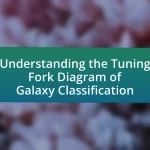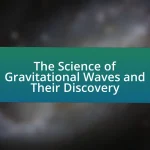The article focuses on planetary orbits and the significance of Kepler’s Laws in understanding celestial mechanics. It explains how gravitational forces shape the elliptical paths of planets around the Sun, detailing Kepler’s three laws: the Law of Ellipses, the Law of Equal Areas, and the Law of Harmonies. The article also discusses the historical context of these laws, their implications for modern astronomy and space exploration, and how they relate to Newton’s Law of Universal Gravitation. Additionally, it addresses common misconceptions about planetary motion and offers tips for effectively studying and applying Kepler’s Laws.

What are Planetary Orbits and Their Importance in Astronomy?
Planetary orbits are the paths that planets follow as they revolve around a star, primarily influenced by gravitational forces. These orbits are crucial in astronomy as they help scientists understand the dynamics of celestial bodies, predict planetary positions, and study the formation and evolution of solar systems. For instance, Johannes Kepler formulated three laws of planetary motion that describe these orbits: the law of ellipses, the law of equal areas, and the law of harmonies, which provide a mathematical framework for predicting planetary positions and understanding gravitational interactions. This understanding is essential for navigation, space exploration, and studying the potential for life on other planets.
How do planetary orbits differ from other celestial movements?
Planetary orbits differ from other celestial movements primarily in their elliptical shape and the gravitational forces that govern them. According to Kepler’s First Law, planets move in ellipses with the Sun at one focus, which contrasts with other celestial bodies, such as comets or asteroids, that may have more varied and often highly eccentric orbits. Additionally, the motion of planets is primarily influenced by the gravitational pull of the Sun, while other celestial movements, like the rotation of moons or the motion of stars, can be affected by different gravitational interactions and forces. This distinction is further supported by Kepler’s Second Law, which states that a line segment joining a planet and the Sun sweeps out equal areas during equal intervals of time, highlighting the unique nature of planetary motion compared to other celestial dynamics.
What factors influence the shape of planetary orbits?
The shape of planetary orbits is primarily influenced by gravitational forces, the mass of the celestial bodies involved, and their relative distances. Gravitational forces, as described by Newton’s law of universal gravitation, dictate how bodies attract each other, leading to elliptical orbits as defined by Kepler’s first law. The mass of the central body, such as a star, determines the strength of its gravitational pull, which in turn affects the orbiting body’s trajectory. Additionally, the initial velocity and distance from the central body at which a planet is located contribute to the eccentricity of the orbit, determining how elongated or circular the orbit appears. These principles are supported by observational data from celestial mechanics and the historical work of astronomers like Johannes Kepler, who formulated the laws governing planetary motion.
Why are planetary orbits crucial for understanding the solar system?
Planetary orbits are crucial for understanding the solar system because they reveal the gravitational interactions and dynamics between celestial bodies. These orbits, governed by Kepler’s laws, demonstrate how planets move in elliptical paths around the sun, which helps scientists predict their positions and behaviors. For instance, Kepler’s First Law states that planets travel in ellipses with the sun at one focus, providing insight into the varying distances and speeds of planets throughout their orbits. This understanding is essential for navigation, space exploration, and studying the formation and evolution of the solar system.
What historical context led to the formulation of Kepler’s Laws?
The historical context leading to the formulation of Kepler’s Laws includes the transition from geocentric to heliocentric models of the solar system. This shift was significantly influenced by the work of Nicolaus Copernicus, who proposed that the Sun, rather than the Earth, is at the center of the universe, as detailed in his 1543 publication “De revolutionibus orbium coelestium.” Kepler built upon the precise observational data collected by Tycho Brahe, particularly regarding Mars, which was crucial for his development of the laws. Brahe’s meticulous measurements, conducted in the late 16th century, provided the empirical foundation that allowed Kepler to derive his three laws of planetary motion between 1609 and 1619. These laws fundamentally changed the understanding of celestial mechanics and established a new framework for astronomy.
Who was Johannes Kepler and what were his contributions?
Johannes Kepler was a German mathematician and astronomer known for formulating the three fundamental laws of planetary motion. His contributions include Kepler’s First Law, which states that planets move in elliptical orbits with the Sun at one focus; Kepler’s Second Law, which describes the speed of a planet as varying depending on its distance from the Sun; and Kepler’s Third Law, which establishes a relationship between the time a planet takes to orbit the Sun and its average distance from the Sun. These laws were pivotal in advancing the heliocentric model of the solar system and laid the groundwork for Newton’s theory of gravitation.
How did Kepler’s observations challenge previous astronomical models?
Kepler’s observations challenged previous astronomical models by demonstrating that planets move in elliptical orbits rather than circular ones, as proposed by Ptolemaic and Copernican systems. His meticulous analysis of Mars’ motion revealed that the distance between a planet and the Sun varies throughout its orbit, contradicting the long-held belief in uniform circular motion. This finding was encapsulated in Kepler’s First Law of Planetary Motion, published in 1609, which fundamentally altered the understanding of celestial mechanics and laid the groundwork for Newton’s law of universal gravitation.
What are Kepler’s Three Laws of Planetary Motion?
Kepler’s Three Laws of Planetary Motion are fundamental principles that describe the motion of planets around the Sun. The first law, known as the Law of Ellipses, states that planets move in elliptical orbits with the Sun at one focus. The second law, the Law of Equal Areas, indicates that a line segment joining a planet and the Sun sweeps out equal areas during equal intervals of time, meaning planets move faster when closer to the Sun. The third law, the Law of Harmonies, establishes a relationship between the time a planet takes to orbit the Sun and its average distance from the Sun, specifically that the square of the orbital period is proportional to the cube of the semi-major axis of its orbit. These laws were formulated by Johannes Kepler in the early 17th century and are based on meticulous observations made by Tycho Brahe.
What is Kepler’s First Law and how does it describe planetary orbits?
Kepler’s First Law states that planets move in elliptical orbits with the Sun at one focus of the ellipse. This law describes the shape of planetary orbits, indicating that the distance between a planet and the Sun varies throughout its orbit. The elliptical nature of these orbits was derived from observational data collected by Tycho Brahe and later analyzed by Johannes Kepler, leading to the conclusion that the gravitational forces acting on planets result in this specific orbital shape.
What is the significance of elliptical orbits in this law?
Elliptical orbits are significant in Kepler’s laws as they describe the actual paths that planets take around the sun, deviating from the previously assumed circular orbits. Kepler’s First Law states that planets move in ellipses with the sun at one focus, which accurately reflects the gravitational dynamics observed in the solar system. This was validated through precise astronomical observations, such as those made by Tycho Brahe, which showed that the orbits of planets like Mars are not perfect circles but ellipses, leading to a more accurate understanding of planetary motion.
How does the distance from the sun affect a planet’s orbit?
The distance from the sun significantly affects a planet’s orbit by determining its orbital period and shape. According to Kepler’s Third Law, the square of a planet’s orbital period is directly proportional to the cube of its average distance from the sun. This means that planets farther from the sun take longer to complete one orbit compared to those that are closer. For example, Earth, which is about 93 million miles from the sun, has an orbital period of one year, while Neptune, located approximately 2.7 billion miles away, takes about 165 Earth years to orbit the sun. This relationship illustrates how distance influences both the time it takes for a planet to orbit and the dynamics of its elliptical path.
How does Kepler’s Second Law explain the speed of planets?
Kepler’s Second Law, also known as the Law of Equal Areas, explains that a planet moves faster when it is closer to the Sun and slower when it is farther away. This law states that a line segment joining a planet and the Sun sweeps out equal areas during equal intervals of time, indicating that the planet’s speed varies depending on its distance from the Sun. For example, when a planet is at perihelion (closest to the Sun), it travels at a higher velocity compared to when it is at aphelion (farthest from the Sun). This variation in speed is a direct consequence of the gravitational force exerted by the Sun, which is stronger at shorter distances, resulting in increased acceleration and speed of the planet.
What does the law of equal areas mean for planetary motion?
The law of equal areas, formulated by Johannes Kepler, states that a line segment joining a planet and the Sun sweeps out equal areas during equal intervals of time. This means that a planet moves faster when it is closer to the Sun and slower when it is farther away. The law reflects the conservation of angular momentum in planetary motion, indicating that the gravitational force from the Sun causes variations in a planet’s speed as it orbits. This principle is foundational in understanding the elliptical orbits of planets, as it explains the varying velocities that planets experience throughout their orbits.
How does this law relate to the gravitational forces at play?
Kepler’s laws describe the motion of planets in their orbits, which are influenced by gravitational forces. Specifically, the law of universal gravitation, formulated by Isaac Newton, states that every mass attracts every other mass with a force proportional to the product of their masses and inversely proportional to the square of the distance between their centers. This gravitational force is what governs the elliptical orbits described in Kepler’s first law, where planets move around the sun in ellipses with the sun at one focus. Additionally, Kepler’s second law, which states that a line segment joining a planet and the sun sweeps out equal areas during equal intervals of time, is a direct consequence of the gravitational force acting on the planet, causing it to speed up as it approaches the sun and slow down as it moves away. Thus, Kepler’s laws are fundamentally rooted in the gravitational forces that dictate the motion of celestial bodies.
What is Kepler’s Third Law and what does it reveal about orbital periods?
Kepler’s Third Law states that the square of the orbital period of a planet is directly proportional to the cube of the semi-major axis of its orbit. This law reveals that planets further from the Sun take longer to complete their orbits compared to those closer to the Sun. Specifically, if T represents the orbital period and a represents the semi-major axis, the relationship can be expressed as T² ∝ a³. This means that if one were to measure the distance of a planet from the Sun, one could predict its orbital period using this mathematical relationship, which has been validated through extensive astronomical observations and calculations.
How can we calculate the relationship between a planet’s distance and its orbital period?
The relationship between a planet’s distance from the sun and its orbital period can be calculated using Kepler’s Third Law of Planetary Motion, which states that the square of a planet’s orbital period (T) is directly proportional to the cube of its average distance (a) from the sun. This relationship is mathematically expressed as T² ∝ a³. For planets orbiting the sun, this can be formulated as T² = k * a³, where k is a constant that depends on the mass of the sun and the gravitational constant. This law has been validated through extensive astronomical observations, confirming that planets further from the sun take longer to complete their orbits compared to those that are closer.
What implications does this law have for understanding exoplanets?
Kepler’s laws of planetary motion significantly enhance our understanding of exoplanets by providing a framework for predicting their orbits and characteristics. Specifically, the first law, which states that planets move in elliptical orbits with the star at one focus, allows astronomers to determine the shape and size of an exoplanet’s orbit. The second law, which indicates that a line segment joining a planet and its star sweeps out equal areas during equal intervals of time, helps in understanding the speed variations of exoplanets in their orbits. The third law, which relates the square of the orbital period of a planet to the cube of the semi-major axis of its orbit, enables the calculation of an exoplanet’s distance from its star and its orbital period. These laws have been validated through extensive observations, such as those conducted by the Kepler Space Telescope, which has confirmed the existence of thousands of exoplanets and provided data that aligns with Kepler’s predictions.
How do Kepler’s Laws Apply to Modern Astronomy?
Kepler’s Laws apply to modern astronomy by providing foundational principles that describe the motion of celestial bodies. Specifically, Kepler’s First Law states that planets move in elliptical orbits with the Sun at one focus, which is crucial for understanding planetary motion and predicting positions of planets. Kepler’s Second Law, which asserts that a line segment joining a planet and the Sun sweeps out equal areas during equal intervals of time, helps astronomers calculate the speed of planets in their orbits. Finally, Kepler’s Third Law establishes a relationship between the orbital period of a planet and its distance from the Sun, allowing for the determination of distances in the solar system. These laws are validated through extensive observations and measurements, such as those conducted by the Hubble Space Telescope and missions like Kepler, which have confirmed the elliptical nature of exoplanetary orbits and the accuracy of orbital period calculations.
What role do Kepler’s Laws play in space exploration?
Kepler’s Laws play a crucial role in space exploration by providing the foundational principles that govern the motion of celestial bodies. These laws enable scientists and engineers to predict the orbits of planets, moons, and spacecraft with high accuracy. For instance, Kepler’s First Law states that planets move in elliptical orbits with the Sun at one focus, which is essential for calculating trajectories for missions to other planets. Kepler’s Second Law, which describes the speed of a planet in its orbit, allows for the optimization of fuel usage during space missions. Finally, Kepler’s Third Law relates the orbital period of a planet to its distance from the Sun, facilitating the planning of satellite orbits and interplanetary travel. The application of these laws has been validated through numerous successful missions, such as the Mars rovers and Voyager spacecraft, which relied on precise orbital calculations derived from Kepler’s principles.
How are these laws used in mission planning for spacecraft?
Kepler’s laws are utilized in mission planning for spacecraft to accurately predict orbital paths and optimize trajectories. These laws, which describe the motion of planets around the sun, provide essential parameters such as the shape of orbits (elliptical), the relationship between orbital period and distance from the sun, and the timing of planetary alignments. For instance, mission planners apply Kepler’s Third Law to determine the necessary velocity and energy required for spacecraft to enter or exit specific orbits, ensuring efficient fuel usage and mission success. Historical missions, such as the Mars Reconnaissance Orbiter, relied on these principles to calculate launch windows and trajectory adjustments, demonstrating the practical application of Kepler’s laws in real-world space exploration.
What advancements in technology have enhanced our understanding of planetary orbits?
Advancements in technology such as high-precision telescopes, space probes, and computer simulations have significantly enhanced our understanding of planetary orbits. High-precision telescopes, like the Hubble Space Telescope, have allowed astronomers to observe distant celestial bodies with unprecedented clarity, leading to more accurate measurements of their orbits. Space probes, such as Voyager and New Horizons, have provided direct data on the gravitational influences and orbital mechanics of planets in our solar system. Additionally, advanced computer simulations enable scientists to model complex gravitational interactions and predict orbital behaviors, refining our understanding of Kepler’s laws and the dynamics of planetary systems. These technological advancements collectively contribute to a more comprehensive understanding of how planets move and interact in space.
How do Kepler’s Laws relate to Newton’s Law of Universal Gravitation?
Kepler’s Laws describe the motion of planets in elliptical orbits, while Newton’s Law of Universal Gravitation provides the underlying force that governs these motions. Specifically, Kepler’s First Law states that planets move in ellipses with the Sun at one focus, which is explained by Newton’s gravitational force acting as the centripetal force required for such orbits. Kepler’s Second Law, which indicates that a line segment joining a planet and the Sun sweeps out equal areas during equal intervals of time, is a consequence of the conservation of angular momentum, which is influenced by the gravitational attraction described by Newton. Finally, Kepler’s Third Law establishes a relationship between the orbital period of a planet and its distance from the Sun, which can be derived from Newton’s gravitational law, showing that the square of the orbital period is proportional to the cube of the semi-major axis of its orbit. Thus, Kepler’s Laws are empirical observations that are mathematically supported and explained by Newton’s Law of Universal Gravitation.
What is the connection between gravitational forces and planetary motion?
Gravitational forces are the primary mechanism that governs planetary motion, as they create the attractive force between celestial bodies. This force, described by Newton’s law of universal gravitation, states that every mass attracts every other mass with a force proportional to the product of their masses and inversely proportional to the square of the distance between their centers. This gravitational attraction causes planets to follow elliptical orbits around stars, as articulated in Kepler’s laws of planetary motion, particularly the first law, which states that planets move in ellipses with the sun at one focus. The consistency of these orbits can be observed through precise measurements of planetary positions, confirming that gravitational forces dictate their paths in space.
How did Newton build upon Kepler’s findings?
Newton built upon Kepler’s findings by formulating the law of universal gravitation, which provided a theoretical framework for Kepler’s empirical laws of planetary motion. While Kepler described how planets move in elliptical orbits around the sun, Newton explained that this motion is a result of gravitational forces acting between the sun and the planets. Specifically, Newton’s first law of motion and his law of gravitation mathematically demonstrated that the force of gravity decreases with distance, which accounted for the elliptical shapes of orbits as described by Kepler. This connection between gravitational force and orbital motion validated Kepler’s observations and unified celestial and terrestrial mechanics, establishing a comprehensive model of motion that remains foundational in physics.

What are the Practical Applications of Understanding Planetary Orbits?
Understanding planetary orbits has practical applications in various fields, including space exploration, satellite deployment, and climate modeling. For instance, knowledge of orbital mechanics allows engineers to design spacecraft trajectories for missions to other planets, ensuring efficient fuel usage and timely arrivals. Additionally, satellite positioning relies on precise calculations of orbits to maintain communication and weather monitoring systems, which are crucial for modern infrastructure. Furthermore, understanding orbits aids in predicting celestial events, such as eclipses and planetary alignments, which have implications for both scientific research and public interest. These applications demonstrate the importance of planetary orbit knowledge in advancing technology and enhancing our understanding of the universe.
How can knowledge of planetary orbits benefit satellite technology?
Knowledge of planetary orbits significantly benefits satellite technology by enabling precise calculations for satellite trajectories and positioning. Understanding Kepler’s laws of planetary motion allows engineers to predict satellite paths, optimize launch windows, and maintain stable orbits. For instance, satellites in geostationary orbit require precise alignment with Earth’s rotation, which is informed by knowledge of orbital mechanics. This precision is crucial for applications such as GPS, where accurate positioning relies on satellites maintaining specific orbits. Historical data shows that successful satellite launches and operations, like those of the Global Positioning System, depend on these principles, demonstrating the practical impact of orbital knowledge on satellite technology.
What are the implications for GPS and communication satellites?
The implications for GPS and communication satellites are significant, as their functionality relies on precise orbital mechanics governed by Kepler’s laws. These laws dictate the motion of satellites, ensuring accurate positioning and reliable communication. For instance, GPS satellites must maintain specific orbits to provide accurate location data; deviations can lead to errors in positioning, affecting navigation systems globally. Additionally, communication satellites depend on stable orbits to maintain consistent signal transmission, with any orbital instability potentially disrupting services. The alignment of satellites in their designated orbits, as described by Kepler’s laws, is crucial for minimizing latency and maximizing coverage, thereby directly impacting the effectiveness of global communication networks.
How does orbital mechanics influence satellite launch strategies?
Orbital mechanics significantly influences satellite launch strategies by determining the optimal trajectories and timing for launches to achieve desired orbits. The principles of orbital mechanics, including Kepler’s laws of planetary motion, dictate how satellites must be launched to enter and maintain stable orbits around Earth. For instance, the first law states that orbits are elliptical, which means that launch angles and velocities must be carefully calculated to ensure that a satellite reaches its intended orbit efficiently.
Additionally, the second law indicates that a satellite’s speed varies depending on its distance from Earth, affecting the launch window and required propulsion. Launching during specific windows, such as when the Earth rotates to align with the satellite’s intended orbit, maximizes efficiency and minimizes fuel consumption. Historical examples, such as the launch of the Hubble Space Telescope, illustrate how precise calculations based on orbital mechanics were essential for successful deployment and operation.
What are some common misconceptions about planetary orbits?
Common misconceptions about planetary orbits include the belief that orbits are perfectly circular and that planets move at constant speeds. In reality, planetary orbits are elliptical, as described by Kepler’s First Law, which states that planets travel in ellipses with the Sun at one focus. Additionally, according to Kepler’s Second Law, planets move faster when they are closer to the Sun and slower when they are farther away, demonstrating that their speeds are not constant. These principles are supported by extensive observational data and mathematical modeling, confirming that the dynamics of planetary motion are more complex than often assumed.
Why do people often confuse circular and elliptical orbits?
People often confuse circular and elliptical orbits because both types of orbits describe the paths of celestial bodies around a focal point, typically a star or planet. The similarity in their descriptions leads to misunderstandings, as circular orbits can be seen as a special case of elliptical orbits where the eccentricity is zero. Additionally, many visual representations simplify orbits to circular shapes, reinforcing the misconception. Kepler’s laws of planetary motion illustrate that while all planets follow elliptical paths, the differences in eccentricity can be subtle, making it easy for individuals to overlook the distinctions between the two types of orbits.
How can understanding Kepler’s Laws clarify these misconceptions?
Understanding Kepler’s Laws clarifies misconceptions about planetary motion by providing a clear framework for how planets orbit the sun. Kepler’s First Law states that planets move in elliptical orbits with the sun at one focus, which corrects the common belief that orbits are circular. The Second Law, which describes how a line segment joining a planet and the sun sweeps out equal areas in equal times, addresses misconceptions about uniform speed in orbits, illustrating that planets move faster when closer to the sun. Finally, the Third Law establishes a precise mathematical relationship between the orbital period of a planet and its distance from the sun, countering the misconception that these factors are unrelated. These laws, derived from empirical observations, provide a scientific basis for understanding the dynamics of planetary motion, reinforcing the accuracy of celestial mechanics.
What tips can help in studying and applying Kepler’s Laws effectively?
To study and apply Kepler’s Laws effectively, focus on understanding the three laws: the Law of Orbits, the Law of Areas, and the Law of Periods. First, visualize planetary motion through diagrams that illustrate elliptical orbits, as this aids in grasping the concept of elliptical paths. Second, practice calculations involving orbital periods and distances using the formulas derived from Kepler’s Laws, which can reinforce comprehension through application. Third, utilize simulations or software that model planetary motion to observe the laws in action, enhancing practical understanding. Historical context, such as Kepler’s work in the early 17th century, provides insight into the significance of these laws in astronomy, further solidifying their relevance.




